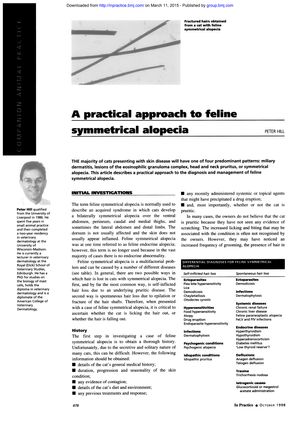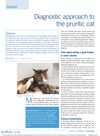A Practical Approach to Feline Symmetrical Alopecia
October 1998
in “
In Practice
”
feline symmetrical alopecia trichograms skin biopsies ectoparasites allergies systemic diseases endocrinopathies prednisolone antihistamines essential fatty acids mood modifiers opioid antagonists hypothyroidism thyroid hormone supplementation testosterone therapy progestogen therapy hair loss skin tests blood tests urine tests parasites hormone disorders steroids fatty acids hormone replacement

TLDR The conclusion is to thoroughly test for causes of cat hair loss and treat accordingly, considering medication only after serious conditions are ruled out.
The 1998 document outlines a method for diagnosing and treating feline symmetrical alopecia, emphasizing the need to differentiate between self-inflicted and spontaneous hair loss. It recommends a thorough examination and various tests, including trichograms, blood and urine analyses, and skin biopsies, to identify underlying causes such as ectoparasites, allergies, systemic diseases, or endocrinopathies. If no specific cause is found, symptomatic management may involve medications like prednisolone, antihistamines, essential fatty acids, mood modifiers, or opioid antagonists. The paper also discusses the rarity of hypothyroidism in cats but suggests thyroid hormone supplementation in some cases, while advising caution with testosterone and progestogen therapy due to side effects. The document stresses the importance of excluding serious medical conditions before considering the alopecia as a cosmetic issue and the necessity of discussing treatment options with the cat owner.




